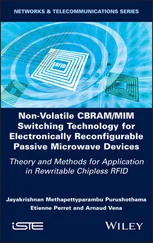Joel P. Dunsmore - Handbook of Microwave Component Measurements
Здесь есть возможность читать онлайн «Joel P. Dunsmore - Handbook of Microwave Component Measurements» — ознакомительный отрывок электронной книги совершенно бесплатно, а после прочтения отрывка купить полную версию. В некоторых случаях можно слушать аудио, скачать через торрент в формате fb2 и присутствует краткое содержание. Жанр: unrecognised, на английском языке. Описание произведения, (предисловие) а так же отзывы посетителей доступны на портале библиотеки ЛибКат.
- Название:Handbook of Microwave Component Measurements
- Автор:
- Жанр:
- Год:неизвестен
- ISBN:нет данных
- Рейтинг книги:5 / 5. Голосов: 1
-
Избранное:Добавить в избранное
- Отзывы:
-
Ваша оценка:
- 100
- 1
- 2
- 3
- 4
- 5
Handbook of Microwave Component Measurements: краткое содержание, описание и аннотация
Предлагаем к чтению аннотацию, описание, краткое содержание или предисловие (зависит от того, что написал сам автор книги «Handbook of Microwave Component Measurements»). Если вы не нашли необходимую информацию о книге — напишите в комментариях, мы постараемся отыскать её.
Handbook of Microwave Component Measurements — читать онлайн ознакомительный отрывок
Ниже представлен текст книги, разбитый по страницам. Система сохранения места последней прочитанной страницы, позволяет с удобством читать онлайн бесплатно книгу «Handbook of Microwave Component Measurements», без необходимости каждый раз заново искать на чём Вы остановились. Поставьте закладку, и сможете в любой момент перейти на страницу, на которой закончили чтение.
Интервал:
Закладка:
8 Chapter 8Figure 8.1 Illustrating the resolution of the RBW filter.Figure 8.2 Comparison of filter shapes: Gaussian, flat‐top, and uniform.Figure 8.3 Spectrum analyzer block diagram up/down‐conversion.Figure 8.4 Diagram of SA tracking YIG filter, with FFT detection.Figure 8.5 Images of a single CW signal, as measured on a non‐image‐protecte...Figure 8.6 Images of two LO settings. Only one signal remains in the same pl...Figure 8.7 Raw IF response of a VNA‐based spectrum analysis mode.Figure 8.8 Corrected IF response.Figure 8.9 Comparing amplitude accuracy for different SA channel FFT widths....Figure 8.10 Response of VNA‐based FFT SA with different FFT widths.Figure 8.11 Swept‐mode SA measurement of an AWGN signal.Figure 8.12 CDF curve for an AWGN signal and a QPSK signal.Figure 8.13 CCDF cures of AWGN and QPSK signals.Figure 8.14 The time‐domain amplitude (in dBm) of an AWGN signal.Figure 8.15 Arb signal with 101 tones, zero phase, in the time domain.Figure 8.16 FFT mode SA measurement of an AWGN signal.Figure 8.17 Swept‐mode SA measurement with slow sweep time.Figure 8.18 Swept‐mode measurement of AWGN signal with 30 kHz VBW.Figure 8.19 FFT mode measurement of AWGN with 30 kHz VBW.Figure 8.20 Measure of AWGN signal with 75 kHz RBW.Figure 8.21 AWGN signal where RBW acquisition time is longer than the wavefo...Figure 8.22 Swept‐mode display with narrow RBW matches FFT mode.Figure 8.23 Close‐in spectrum of AWGN waveform showing multitone components....Figure 8.24 Coherent time averaging (or vector averaging) reduces noise on a...Figure 8.25 Band‐power measurements show difference between using peak and a...Figure 8.26 Band‐power readings don't change with change in RBW.Figure 8.27 Lowering the RBW lowers the minimum detectable power with multit...Figure 8.28 Same measurement as above with 20 dB lower signal power.Figure 8.29 Vector averaging used to improve detection sensitivity.Figure 8.30 Vector averaging improves power detection in normal band‐power m...Figure 8.31 Amplitude accuracy in swept mode SA at 24 GHz center frequency: ...Figure 8.32 Wideband power accuracy of VNA spectrum analyzer mode.Figure 8.33 IMD measurements with offsets in the main tone power.Figure 8.34 Projecting IM tones to obtain the IP3 point.Figure 8.35 SA and VNA measurement of IM spectrums.Figure 8.36 Swept‐power IMD measurements.Figure 8.37 Swept‐center frequency IMD measurements.Figure 8.38 Swept‐delta frequency IMD measurements.Figure 8.39 Block diagram of combined source with isolators.Figure 8.40 Source‐generated IMD due to direct cross‐modulation with and wit...Figure 8.41 Receiver‐generated IMD in swept IMD mode, at +5 dBm input, with ...Figure 8.42 Spectrum of an AWGN driven into an amplifier that is non‐linear....Figure 8.43 ACPR measure of a 64QAM signal measured through an amplifier; lo...Figure 8.44 Multicarrier adjacent channel level measurements with one channe...Figure 8.45 Traditional setup for generating an NPR signal.Figure 8.46 CCDF curve of a noise‐like waveform generated from a random phas...Figure 8.47 NPR signal with band‐power markers.Figure 8.48 NPR using Band Noise markers to get a direct reading of NPR.Figure 8.49 NPR signal with no corrections.Figure 8.50 Corrected NPR signal.Figure 8.51 NPR measurement using mutitone detection methods.Figure 8.52 NPR with vector averaging.Figure 8.53 Mapping data to IQ space.Figure 8.54 Filtering the IQ waveform.Figure 8.55 Mapping IQ to a constellation diagram.Figure 8.56 Gain, delay, and clipping on a signal.Figure 8.57 Sampling the signal at the symbol rate.Figure 8.58 Filtering the received signal.Figure 8.59 Renormalizing the received signal.Figure 8.60 Time aligning the signal.Figure 8.61 Resampling and the delta IQ waveforms.Figure 8.62 I and Q magnitude‐squared waveforms.Figure 8.63 Measuring EVM with a VNA.Figure 8.64 QPSK and QAM signals; upper plot is constellation diagrams, and ...Figure 8.65 Display from PNA‐X Modulation Distortion application, with equal...Figure 8.66 High‐order products from a two‐stage frequency converter.Figure 8.67 Measurement of the three ports (RF – input, LO, and IF – output)...Figure 8.68 Measurements of an unstable spur using traditional swept SA (upp...Figure 8.71 Time‐gated spectrum analysis (upper) and pulse profile (lower)....Figure 8.69 Spectrum of a signal pulsed with 1 μ s with 10% duty cycle....Figure 8.70 Wideband spectrum of a pulsed signal.Figure 8.72 Measuring a close‐in spur in a pulsed signal. The upper plot sho...
9 Chapter 9Figure 9.1 Noise bandwidth of a VNA with zero‐IF receiver.Figure 9.2 Noise variation over 1000 samples, with a 1 or 100 averaging.Figure 9.3 Measured error versus input noise power.Figure 9.4 Y‐factor computation based on hot and cold sources, and effects o...Figure 9.5 Noise figure computed from cold source; also shown is the Y‐facto...Figure 9.6 Noise parameters describe the noise figure as a function of sourc...Figure 9.7 An amplifier with internal noise sources.Figure 9.8 Noise representation of a 2‐port network using s‐parameter repres...Figure 9.9 Noise parameter represented as T‐matrix.Figure 9.10 Traditional noise parameter measurement system.Figure 9.11 VNA system for making vector‐error‐corrected noise‐figure measur...Figure 9.12 Vector‐corrected noise‐figure measurement, compared to Y‐factor ...Figure 9.13 Noise parameter using Ecal as a tuner.Figure 9.14 Tuner‐based noise parameters.Figure 9.15 Noise parameters using a mechanical tuner.Figure 9.16 Defining the G/T of an active antenna.Figure 9.17 Using Y‐factor to measure G/T.Figure 9.18 VNA using cold‐source method to measure G/T.Figure 9.19 Range loss measurement.Figure 9.20 Y‐factor mixer measurement illustration of double‐sideband noise...Figure 9.21 Comparison of Y‐factor NF, cold‐source NF, and SC 21.Figure 9.22 Comparison of Y‐factor and cold‐source on a mixer with no image ...Figure 9.23 Errors due to excess converted noise of the LO.Figure 9.24 Error in noise figure due to excess LO noise.Figure 9.25 SA noise measurements with various settings image reject and RBW...Figure 9.26 Hot and cold noise measurements and Y‐factor computation, compar...Figure 9.27 Carrier to noise measurements as well as a measure of input sign...Figure 9.28 Noise‐figure verification device.Figure 9.29 Photo of the actual verification device.Figure 9.30 Signal flow diagram of a noise verification device.Figure 9.31 Signal flow diagram from computing the overall gain of the verif...Figure 9.32 Signal low diagram for noise power out under matched conditions....Figure 9.33 Relative noise power from the verification device.Figure 9.34 ADS simulation of the verification device.Figure 9.35 Comparing ADS simulation with analytic computation.Figure 9.36 Difference between ADS simulation and analytic computation.Figure 9.37 Measurement of NF verification device versus analytic computatio...Figure 9.38 NFA 4002 measurement compared to analytic computation.Figure 9.39 NFA 4000 measurement compared to analytic computation.
10 Chapter 10Figure 10.1 A 4‐port network used as a balanced amplifier.Figure 10.2 A 3‐port device used as a single‐ended to balanced device.Figure 10.3 A PC test board for characterizing differential lines.Figure 10.4 16 S‐parameters of a balanced transmission line.Figure 10.5 Comparing S 21, S 23, and S dd21.Figure 10.6 Display of all 16 mixed‐mode parameters, each mode is displayed ...Figure 10.7 Frequency domain (upper); time domain of Sdd11 and Scc11 (lower)...Figure 10.8 4‐port single‐ended S‐parameters of a differential device.Figure 10.9 Mixed‐mode parameters for a differential amplifier.Figure 10.10 A differential amplifier driven with a single‐ended signal.Figure 10.11 Example schematic of a differential amplifier.Figure 10.12 Driving an amplifier with true‐mode (upper) and single‐ended (l...Figure 10.13 An example case where the input is non‐linear and not‐different...Figure 10.14 Non‐linear non‐differential input driven with a true‐differenti...Figure 10.15 Amplifier with input clipping.Figure 10.16 Two‐tone response of a non‐linear differential amplifier.Figure 10.17 Block diagram of a 4‐port dual source VNA.Figure 10.18 Error in phase due to DUT mismatch.Figure 10.19 True mode vs. single‐ended measurements for differential S‐para...Figure 10.20 True‐mode vs. single‐ended measurements for common‐mode S‐param...Figure 10.21 Fixed‐frequency swept‐power measurement showing differential ga...Figure 10.22 Differential gain for a normal differential amplifier, measured...Figure 10.23 Swept power measurements of the mixed‐mode transmission paramet...Figure 10.24 Non‐linear magnitude and phase response of S dd21for SE and tru...Figure 10.25 User interface for setting phase sweep.Figure 10.26 Phase‐skew test on a differential amplifier.Figure 10.27 Setup for differential harmonics.Figure 10.28 Gain, harmonic power, and THD of a differential amplifier.Figure 10.29 Output power, second and third harmonic versus input phase.Figure 10.30 Second harmonic response (upper), third harmonic repsonse (lowe...Figure 10.31 Swept power harmonics, with single‐ended and differential resul...Figure 10.32 Swept‐power harmonics (upper) and THD (lower).Figure 10.33 Examples of several RF transformers, baluns, and a hybrid.Figure 10.34 User interface to save mixed‐mode parameters to an S2P file.Figure 10.35 Measurement of SE to differential response from the difference ...Figure 10.36 Measurement of SE to common‐mode response from the sum port of ...Figure 10.37 Test setup for using hybrids to test differential parameters.Figure 10.38 Frequency response for differential parameters using de‐embeddi...Figure 10.39 Non‐linear response to a power sweep using hybrids to test S dd2...Figure 10.40 Swept‐frequency IMD measurements.Figure 10.41 Spectrum plot of IMD for a differential amplifier measured with...Figure 10.42 Swept‐power IMD measurement of a limiting differential amplifie...Figure 10.43 Measuring IMD on a normal differential amplifier, using hybrids...Figure 10.44 Measurement of IMD for a normal differential amplifier with SE ...Figure 10.45 The SE measurements of a limiting amplifier shows poor predicti...Figure 10.46 Block diagram for differential IMD with external sources.Figure 10.47 Frequency setup for differential IMD without baluns.Figure 10.48 Source setup for differential IMD.Figure 10.49 Differential IMD parameters.Figure 10.50 Swept‐frequency IMD power of a differential amplifier, measured...Figure 10.51 Amplifier with internal noise sources.Figure 10.52 Noise figure and gain, and DUTRNPI measurement for a differenti...Figure 10.53 Common mode gain and noise figure.Figure 10.54 Noise figure measured on single‐ended inputs.Figure 10.55 Differential noise parameters.
Читать дальшеИнтервал:
Закладка:
Похожие книги на «Handbook of Microwave Component Measurements»
Представляем Вашему вниманию похожие книги на «Handbook of Microwave Component Measurements» списком для выбора. Мы отобрали схожую по названию и смыслу литературу в надежде предоставить читателям больше вариантов отыскать новые, интересные, ещё непрочитанные произведения.
Обсуждение, отзывы о книге «Handbook of Microwave Component Measurements» и просто собственные мнения читателей. Оставьте ваши комментарии, напишите, что Вы думаете о произведении, его смысле или главных героях. Укажите что конкретно понравилось, а что нет, и почему Вы так считаете.












